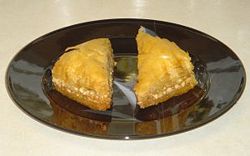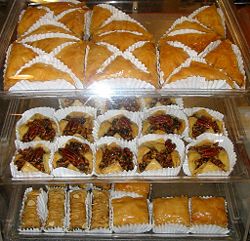Baklava
Baklava or baklawa is a rich, sweet pastry featured in many cuisines of the former Ottoman countries. It is a pastry made of layers of phyllo dough filled with chopped walnuts or pistachios and sweetened with syrup or honey.
Gaziantep, a city in Turkey, is famous for its baklava and, in Turkey, is widely regarded as the native city of the dessert.[1] In 2008, the Turkish patent office registered a geographical indication certificate for Antep Baklava.[2]
Baklava was chosen to represent Cyprus in the presentation Sweet Europe of the cultural initiative Café Europe in 2006.
History
The history of baklava is not well-documented; but although it has been claimed by many ethnic groups, it is said to be Greek but the best evidence is that it is of Central Asian Turkic origin, with its current form being developed in the imperial kitchens of the Topkapı Palace.[3]
Vryonis (1971) identified the ancient Greek gastris, kopte, kopton, or koptoplakous, mentioned in the Deipnosophistae, as baklava, and calls it a "Byzantine favorite." However, Perry (1994) shows that though gastris contained a filling of nuts and honey, it did not include any dough; instead, it involved a honey and ground sesame mixture similar to modern pasteli or halva.
Perry then assembles evidence to show that layered breads were created by Turkic peoples in Central Asia and argues that the "missing link" between the Central Asian folded or layered breads (which did not include nuts) and modern phyllo-based pastries like baklava is the Azerbaijani dish Bakı pakhlavası, which involves layers of dough and nuts. The traditional Uzbek puskal or yupka and Tatar yoka, sweet and salty savories (boreks) prepared with 10-12 layers of dough, are other early examples of layered dough style in Turkic regions.[4]
The thin phyllo dough as used today was probably developed in the kitchens of the Topkapı Palace. Indeed, the sultan presented trays of baklava to the Janissaries every 15th of Ramadan in a ceremonial procession called the Baklava Alayı.[5]
Other claims about its origins include: that it is of Assyrian[6] origin, dates back to ancient Mesopotamia, and was mentioned in a Mesopotamian cookbook on walnut dishes; that al-Baghdadi describes it in his 13th-century cookbook; that it was a popular Byzantine dessert.[7][8] But Claudia Roden[9] and Andrew Dalby[10] find no evidence for it in Arab, Greek, or Byzantine sources before the Ottoman period.
One of the oldest known recipes for a sort of proto-baklava is found in a Chinese cookbook written in 1330 under the Yuan (Mongol) dynasty under the name güllach (Buell, 1999). "Güllaç" is found in Turkish cuisine. Layers of phyllo dough are put one by one in warmed up milk with sugar. It is served with walnut and fresh pomegranate and generally eaten during Ramadan.
Etymology
The word baklava entered English from Turkish;[11][12] it is sometimes connected with the Arabic word for "bean" (بقلة /baqlah/), but Wehr's dictionary lists them as unrelated. Akın and Lambraki [13] state that the word baklava entered into Arabic from Turkish. Buell (1999) argues that the word "baklava" may come from the Mongolian root baγla- 'to tie, wrap up, pile up' composed with the Turkic verbal ending -v. Baklava is found in many cuisines, with minor phonetic variations on the name.
Variations
Baklava is the most famous of the Greek pastries, and every area of Greece - and sometimes every family within a region - has a favorite recipe. Enjoy this favorite of mine, made with walnuts and almonds, olive oil, cinnamon, and cloves. The recipe is a modified version of a Cretan specialty from Roman times, Gastrin.
Notes
- ↑ Guide Martin: Gaziantep
- ↑ Newstime 7, February 21, 2008[1]
- ↑ Perry 1994, 87
- ↑ Akın and Lambraki, Turkish and Greek Cuisine/Türk ve Yunan Mutfağı p. 248-249, ISBN 9754584842
- ↑ Wasti, 2005
- ↑ Baklava , history , origin , recipes
- ↑ John Ash, A Byzantine Journey, page 223
- ↑ Marcus Rautman, Daily Life in the Byzantine Empire, page 96
- ↑ New Book of Middle Eastern Food, 2000, ISBN 0-375-40506-2
- ↑ Siren Feasts: A History of Food and Gastronomy in Greece, 1997, ISBN 0-415-15657-2
- ↑ Merriam-Webster Online, s.v. Baklava
- ↑ Dictionary.com Unabridged, s.v. Baklava
- ↑ Turkish and Greek Cuisine/Türk ve Yunan Mutfağı p. 248-249, ISBN 9754584842
ReferencesISBN links support NWE through referral fees
- Reuven Amitai-Preiss and David O. Morgan, eds., The Mongol Empire and Its Legacy Brill, 1999. ISBN 9004119469
- Paul D. Buell, "Mongol Empire and Turkicization: The Evidence of Food and Foodways," p. 200ff, in Amitai-Preiss, op.cit.
- Christian, David. Review of Amitai-Preiss, op.cit., in Journal of World History 12:2:476 (2001).
- Perry, Charles. "The Taste for Layered Bread among the Nomadic Turks and the Central Asian Origins of Baklava," in A Taste of Thyme: Culinary Cultures of the Middle East (ed. Sami Zubaida, Richard Tapper), 1994. ISBN 1-86064-603-4.
- Claudia, Roden. The New Book of Middle Eastern Food. Knopf, 2000. ISBN 978-0375405068
- Vryonis, Speros, The Decline of Medieval Hellenism in Asia Minor, 1971. Quoted in Perry (1994).
- Wasti, Syed Tanvir, "The Ottoman Ceremony of the Royal Purse," Middle Eastern Studies 41:2:193–200 (March 2005)
External links
Credits
New World Encyclopedia writers and editors rewrote and completed the Wikipedia article in accordance with New World Encyclopedia standards. This article abides by terms of the Creative Commons CC-by-sa 3.0 License (CC-by-sa), which may be used and disseminated with proper attribution. Credit is due under the terms of this license that can reference both the New World Encyclopedia contributors and the selfless volunteer contributors of the Wikimedia Foundation. To cite this article click here for a list of acceptable citing formats.The history of earlier contributions by wikipedians is accessible to researchers here:
The history of this article since it was imported to New World Encyclopedia:
Note: Some restrictions may apply to use of individual images which are separately licensed.


